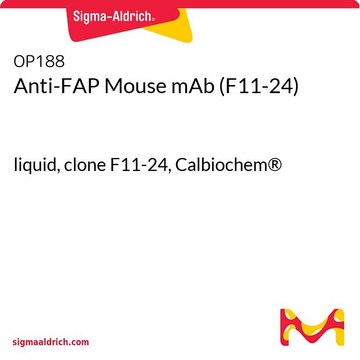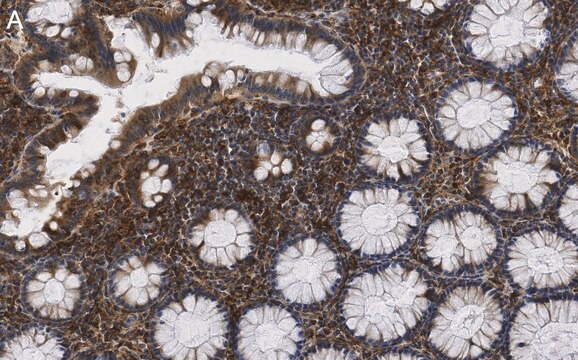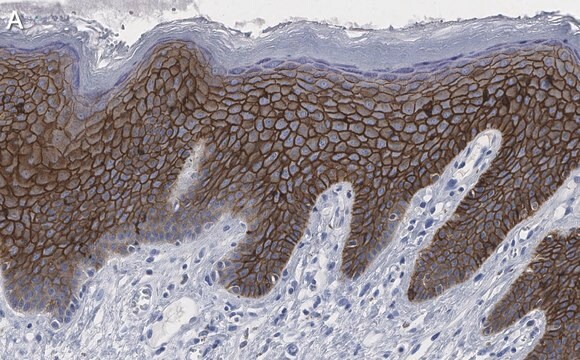MABT366
Anti-Claudin-1/CLDN1 Antibody, clone 7A5
clone 7A5, from mouse
Sinônimo(s):
Claudin-1, Senescence-associated epithelial membrane protein
About This Item
Produtos recomendados
fonte biológica
mouse
Nível de qualidade
forma do anticorpo
purified immunoglobulin
tipo de produto de anticorpo
primary antibodies
clone
7A5, monoclonal
reatividade de espécies
human
não deve reagir com
mouse
técnica(s)
flow cytometry: suitable
immunocytochemistry: suitable
western blot: suitable
Isotipo
IgG1κ
nº de adesão NCBI
nº de adesão UniProt
Condições de expedição
dry ice
modificação pós-traducional do alvo
unmodified
Informações sobre genes
human ... CLDN1(9076) , NISCH(11188)
Descrição geral
Especificidade
Imunogênio
Aplicação
Western Blotting Analysis: 0.5 µg/mL from a representative lot detected exogenously expressed claudin-1 in CLDN1-transfected, but not mock-transfected, HT1080 cells (Courtesy of Professor Masuo Kondoh, PhD, Osaka University, Japan).
Immunocytochemistry Analysis: A representative lot immunostained the surface of Huh-7.5.1 human hepatoma cells, but not the non-claudin-1-/CLDN1-expressing S7-A cells (Fukasawa, M., et al. (2015). J. Virol. 89(9):4866-4879).
Flow Cytometry Analysis: A representative lot specifically immunostained HT1080 cells expressing exogenously transfected human claudin-1 (CLDN1), but not HT1080 cells expressing human claudin-2, -4, -5, -6, -7, or -9, nor L cells expressing mouse claudin-1 (Fukasawa, M., et al. (2015). J. Virol. 89(9):4866-4879).
Flow Cytometry Analysis: A representative lot immunostained HEK293T transfectants expressing FLAG-tagged human claudin-1/CLDN1 and human-mouse claudin-1 chimeras with the second human extracellular loop (EL2), but not chimeras with the mouse EL2. M152L, but not V155I, mutation in human EL2 abolished the immunoreactivity (Fukasawa, M., et al. (2015). J. Virol. 89(9):4866-4879).
Western Blotting Analysis: A representative lot detected FLAG-tagged human claudin-1/CLDN1 and human-mouse claudin-1 chimeras with the second human extracellular loop (EL2), but not chimeras with the mouse EL2. M152L, but not V155I, mutation in the second human extracellular loop abolished the immunoreactivity (Fukasawa, M., et al. (2015). J. Virol. 89(9):4866-4879).
ELISA Analysis: A representative lot detected claudin-1/CLDN1 immunoreactivity in 3.7% formaldehyde-fixed Huh-7.5.1 human hepatoma cells by "cell ELISA" (Fukasawa, M., et al. (2015). J. Virol. 89(9):4866-4879).
Neutralization Analysis: A representative lot inhibited HCV infection of cultured Huh-7.5.1 human hepatoma cells in vitro and of human liver-chimeric mice in vivo (Fukasawa, M., et al. (2015). J. Virol. 89(9):4866-4879).
Cell Structure
Infectious Diseases - Viral
Qualidade
Immunocytochemistry Analysis: 10 µg/mL of this antibody detected Claudin-1/CLDN1 in HepG2 cells.
Descrição-alvo
forma física
Armazenamento e estabilidade
Handling Recommendations: Upon receipt and prior to removing the cap, centrifuge the vial and gently mix the solution. Aliquot into microcentrifuge tubes and store at -20°C. Avoid repeated freeze/thaw cycles, which may damage IgG and affect product performance.
Outras notas
Exoneração de responsabilidade
Não está encontrando o produto certo?
Experimente o nosso Ferramenta de seleção de produtos.
recomendado
Código de classe de armazenamento
12 - Non Combustible Liquids
Classe de risco de água (WGK)
WGK 2
Ponto de fulgor (°F)
Not applicable
Ponto de fulgor (°C)
Not applicable
Certificados de análise (COA)
Busque Certificados de análise (COA) digitando o Número do Lote do produto. Os números de lote e remessa podem ser encontrados no rótulo de um produto após a palavra “Lot” ou “Batch”.
Já possui este produto?
Encontre a documentação dos produtos que você adquiriu recentemente na biblioteca de documentos.
Nossa equipe de cientistas tem experiência em todas as áreas de pesquisa, incluindo Life Sciences, ciência de materiais, síntese química, cromatografia, química analítica e muitas outras.
Entre em contato com a assistência técnica








